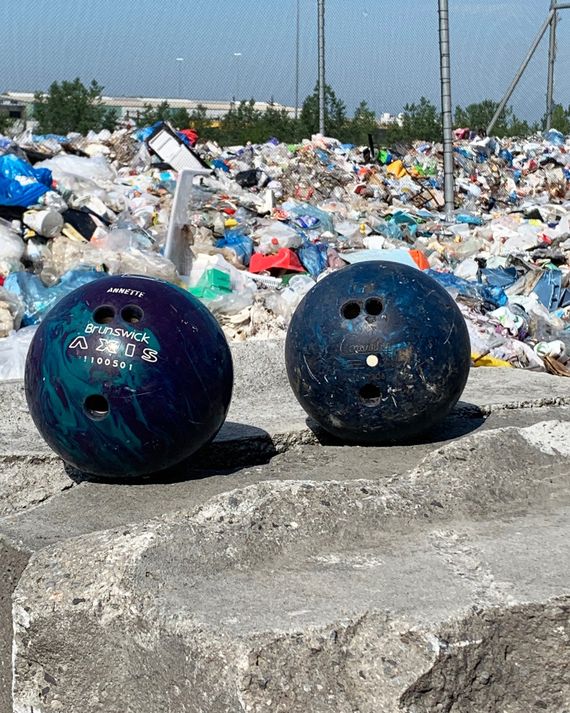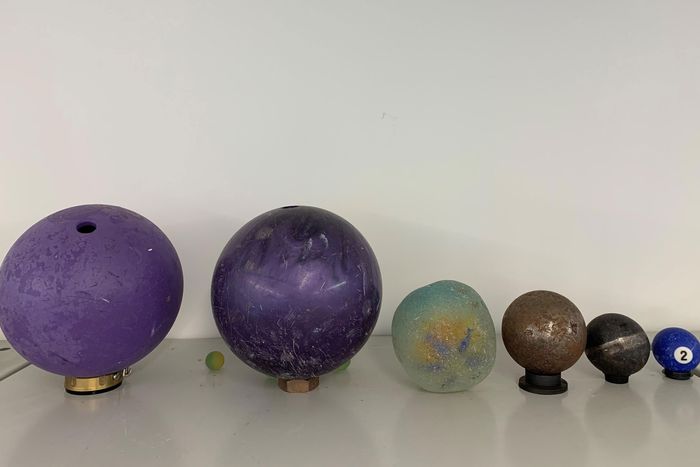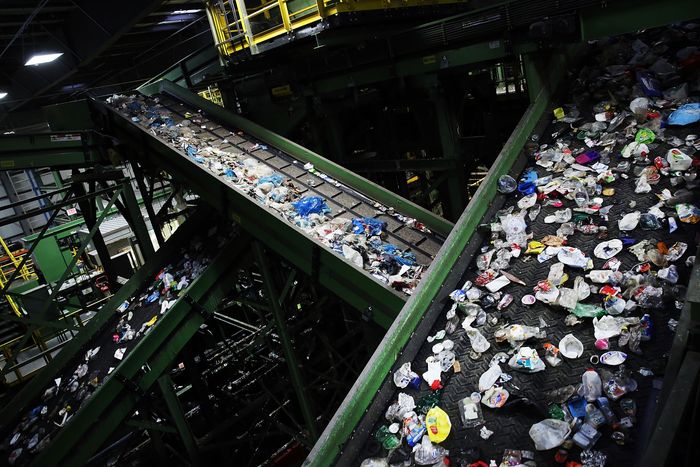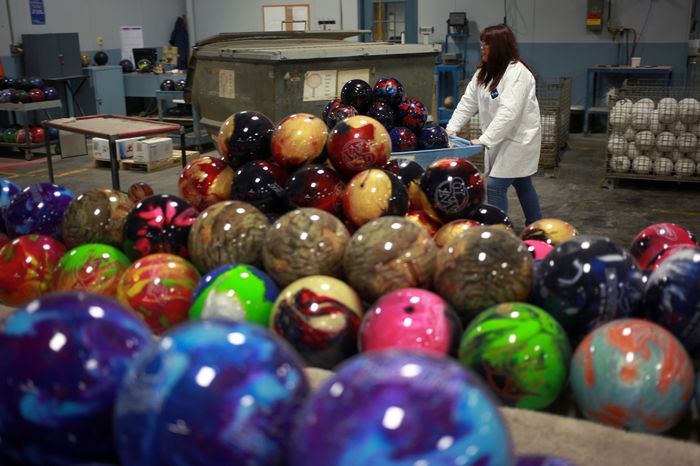
Every day, collection trucks from Brooklyn and barges from Queens and the Bronx arrive at Sims Municipal Recycling in Sunset Park, loaded up with old phone books and plastic sporks, metal faucets and glass bottles. It’s the country’s largest recycling facility of its kind, sorting more than 1,000 tons of New York City’s metal, glass, plastic, and paper each day on 2.4 miles of conveyor belt. Head into Tom Outerbridge’s office at Sims, and you’ll also see a few discarded bowling balls, lined up and ready to roll.
When Outerbridge, who is the facility’s general manager, started at Sims more than 15 years ago, he started rescuing the wayward balls. He very quickly discovered that he could not keep up, because Sims gets an average of three to four bowling balls a day, or roughly 1,200 per year. It was like “walk[ing] on the beach for the first time,” Outerbridge says, “and you’re like, ‘Oh, look at this shell, it’s amazing!’ before you realize there are shells everywhere.”
The Technicolor spheres arrive at Sims in the same plastic bags with all the soda bottles and soup cans, picked up curbside all over the city. People seem to think that because they are plastic, they are the same as, say, takeout containers. They are not. Breaking bowling balls apart and selling the individual components for scrap isn’t logistically or economically feasible — and so they end up in the approximately 20 percent of material that Sims sends on to landfills.
It’s not clear who exactly is throwing out all these bowling balls. Sims only takes in residential recyclables, so they’re not coming in bulk from bowling alleys. And professional bowlers are too well-versed in the science (and sales pitch) behind their balls to think they’re recyclable. “I noticed a lot of them had quite small holes,” Outerbridge says, suggesting they were the outgrown detritus of “kids who dreamed they were going to be pro bowlers.” Kara Napolitano, education and outreach coordinator at Sims, speculates the adult-size balls are pulled out of cobwebbed attics and basements throughout the five boroughs.
Wherever they come from, at least they make pretty decent trash, says Benjamin Miller, a former New York City Department of Sanitation official and the author of Fat of the Land, a 200-year history of the city’s garbage. Bowling balls don’t emit greenhouse gases; they don’t leach anything into the earth or water. Unfortunately, they’re still a neon sign warning of the harsh realities of recycling.
To an amateur bowler, a 6- to 16-pound bowling ball appears virtually indestructible, and the “house balls” filling up the racks at your local bowling alley effectively are. Since the 1970s, most have been covered in polyester, a durable plastic in everything from pillow padding to seat belts. “These things were so hard, they were indestructible,” says Del Warren, a former bowling-ball designer turned coach. “But there was no performance, either.” As a junior-league bowler, Warren’s first ball rolled straight as an arrow and came with a lifetime warranty. In bowling-ball form, polyester can endure 10 or 15 years of daily play, says Tommy Delutz Jr., a two-time national Professional Bowlers Association champion who now runs the pro shop at Herrill Lanes in Nassau County. House balls don’t break. They get stolen.
But elite bowlers, like those on tour with the Professional Bowlers Association, want different equipment. They prefer reactive balls, which combine a different plastic called polyurethane with a liquid plasticizer that creates millions of tiny holes in the cover stock. As a ball rolls 60 feet down an oiled lane, it absorbs some of the grease, giving it a well-timed and powerful “hook” to sweep away pins.
Today, reactive balls are produced by six or seven specialty factories in the United States, Mexico, and Asia. They have weighted cores, which look like “gas masks, hand grenades, guitar bodies, Easter Island statues, [and] Rorschach inkblots,” according to Wired, and are made of a polyester resin filled with varying amounts of calcium carbonate, barium sulfate, and glass microspheres. The cores are then encased in half an inch of urethane cover stock loaded with reactive chemicals, pigments, and, in some cases, scents, such as black cherry and orange coffee cake. The balls come off the line as perfect spheres. It’s the pro shops that later drill custom finger holes.
For all that engineering, the life of a reactive bowling ball is brutally short. At a certain point, a ball can’t absorb any more oil, explains Ronald Hickland Jr., a former ball designer. Many professionals report a corresponding change in their ball behavior in just three games. To win, bowlers throw a few test runs, watch how the ball responds to the unique oil pattern on the lane, and adjust their strategy accordingly. That makes players highly sensitive to the most minute changes in their ball — and willing to dump a poor performer fast. Reactive balls are also inherently more brittle, which makes them more likely to split. “Close your eyes and picture Gondwanaland or the Earth splitting” from the inside out, says Delutz. Once a ball commits “ballicide,” he says, nothing can save it.
All this means that for every ball on the lane, a serious bowler has a half-dozen in a bag. “For a high-end bowler, you really want one per season,” Delutz says. As a professional bowler, “I was personally drilling [200] balls for myself a year.” That’s not totally out of step with other sports: Professional golfers lose about 1.3 balls each round, while baseball players can go through more than 100 balls a game. (New York City won’t recycle those, either.) But only pros, who get their bowling balls free from the brands that sponsor them, can afford to act this way. For everyone else, the average going price for a reactive ball is upwards of $200, which means players will do just about anything, from warming ovens to ultrasonic baths, to keep them in play.
If there’s a way to reuse a bowling ball, someone’s tried it. Pinteresters turn them into lawn ornaments. One Reddit user claims to have used them in target practice. And in 1987, a zoo in Illinois gave them to animals as toys, but they damaged cages, plugged draining holes, and inspired an alarming possessiveness in at least one male lion. Pros often donate old equipment to youth leagues. But most balls end up in the trash, and more than a few make a stop at a recycling plant first.
As new materials arrive at Sims, they’re loaded onto an automated Van Dyk processing system, where magnets, optical sorters, ballistic separators, and a few eagle-eyed workers sort recyclables and remove contaminants. Employees pull bowling balls by hand, dropping them down a chute or piling them with other waste to be carted away to landfills. They join the ranks of other materials that seem recyclable but actually aren’t, including three-ring binders, umbrellas, garden hoses, and eyeglasses.
Sometimes, that process can be perilous. Joe Fusco, vice-president of Casella Waste Systems, which serves several states in New England, said one Massachusetts employee once used a bucket truck to scoop recyclables off the sorting floor, when a bowling ball “came rolling down perfectly along the arm of the lifter and smashed through the windshield.” But most of the time, even contaminants move safely through the system.
From a recycler’s perspective, bowling balls pose two problems. The first is that they’re typically made of thermoset plastic, which means the bonds between its molecules are stronger than those in something like a single-use water bottle — making them difficult or impossible to be melted down and reshaped. The second is that they simply contain too many types of materials. Aluminum cans, for example, are made of (mostly) aluminum, while bowling balls are a composite of dozens of plastics, paints, and other chemicals.
To keep the conveyor belts running, organizations like Sims have to find ways to profit off of the materials they take in, typically by finding secondary-use markets. Aluminum cans can be cleaned, sorted, crushed, and resold to manufacturers who shred, remelt, and solidify the material into new containers. But many materials never find a second life. Hickland, the former bowling-ball designer, said he tried to find out if there were ways for old balls to be repurposed. There was. “We could take a bowling ball and grind it down into asphalt,” he says. But the process took more energy — and cost more money — than it was worth.
“Bowling balls are just the tip of the iceberg,” Miller says. Since the 1960s, we’ve produced 8.3 billion metric tons of plastic globally, only 9 percent of which have ever been recycled. It’s getting harder every day: In 2019, China, once a major buyer for the U.S.’s recovered materials, banned the import of 24 types of waste, including plastics. The policy, called National Sword, sent the global recycling economy spinning.
Yet the average New Yorker still treats recycling as something of a municipal miracle, Napolitano says. “People feel a little better when they put something in the recycling bin, as opposed to the trash,” she told me in 2020, before lockdown. When I last talked to her, in spring 2021, after a year of watching pandemic-driven contamination, her tone had changed. “You’re not absolved,” she said, “just because you’re recycling or using recycled materials.”
To make their jobs easier, Outerbridge and many of his peers are pushing for a policy tool called extended producer responsibility, or EPR, which aims to incorporate environmental costs into the cost of products and compel manufacturers to subsidize recycling, landfilling, or other waste-management efforts for the goods they create.
Typically, EPR efforts have focused on materials with 24- or 48-hour life cycles, like single-use plastic water bottles or food packaging. But Outerbridge says he can see the model extending to all kinds of producers, including bowling-ball companies. Such a policy could make it financially feasible for facilities like SMR to recycle products that currently go to waste, including bowling balls. Depending on how the laws are written up, it would also encourage brands to design with sustainability from the outset.
“Listen, it’s been 30 years since somebody has made a huge leap in performance. We’re overdue,” Warren, the former ball designer, says. “Maybe the next technology will also be a little friendlier in terms of recycling and not ending up in a landfill.”
Of course, there are other end-of-life solutions for a bowling ball. Neil Stremmel, the former head of research for the United States Bowling Congress, the national governing body for the sport, says he’s heard of more than one bowler who has gone so far as to throw a bad ball off a bridge after a tournament.







